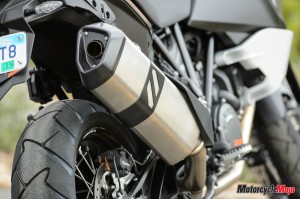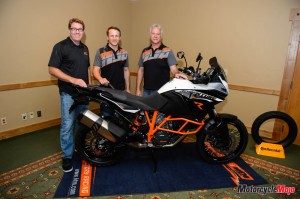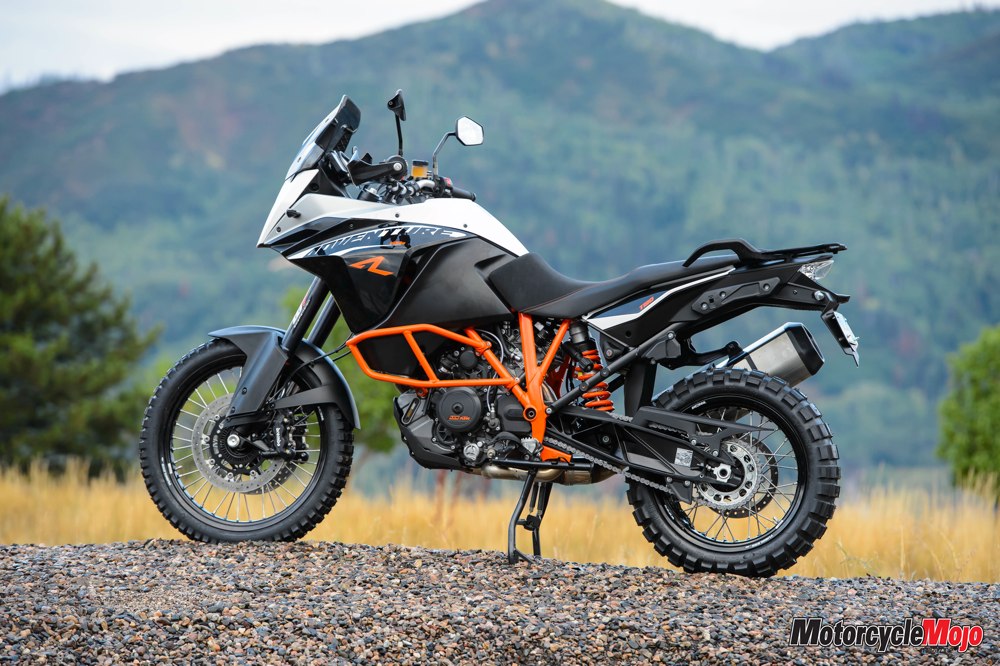KTM claims the Adventure is the world’s safest motorcycle – it uses cutting-edge technology, including lean-sensitive traction control and ABS, and it can tackle any terrain with ease. Could it knock BMW’s R1200GS off the adventure-touring pedestal?
KTM has always specialized in off-road motorcycles, and in some cases, such as in Canada, KTM’s market share in the off-road segment is about 70 percent, a significant number for a small Austrian company. With the launch of the 1190 Adventure for 2014, it’s clear that KTM intends to make serious inroads into the large-displacement bike market, a market dominated by BMW.
KTM has produced motorcycles directed at other segments, like its RC8 supersport machine. The RC8 was the company’s first foray into the sportbike market, and although it had a unique look and competitive performance, it met with limited sales success.
“We weren’t ready,” says Tom Moen, KTM’s media manager. “The RC8 was a great bike, but as a company, we introduced it before our time.”
Better suited to produce bikes meant for more than just pavement, KTM launched the 1190 Adventure and Adventure R models earlier this year. I’m at the launch of the street-oriented 1190 Adventure, held at the Ponte Winery near KTM’s American headquarters in Temecula, California.
Three short years in the making, the 1190 replaces the 990 Adventure to become KTM’s latest flagship motorcycle. It’s a sophisticated, no-compromise machine at the leading edge of production motorcycle technology, with features that were only dreams just a few years ago.
 However, this isn’t an RC8, and the 1190 Adventure has a number of positive qualities for me, including the engine, which I truly consider a work of engineering art. The 1190 uses a detuned version of the 1195 cc, 75-degree V-twin introduced in the RC8 sportbike. In the Adventure, it produces a claimed 150 hp, which is 23 hp less than in the RC8, but still more than anyone would need in an adventure bike. It also produces a claimed peak torque of 92 ft-lb, which is identical to the BMW R1200GS, though the KTM’s torque peaks 1000 rpm sooner.
However, this isn’t an RC8, and the 1190 Adventure has a number of positive qualities for me, including the engine, which I truly consider a work of engineering art. The 1190 uses a detuned version of the 1195 cc, 75-degree V-twin introduced in the RC8 sportbike. In the Adventure, it produces a claimed 150 hp, which is 23 hp less than in the RC8, but still more than anyone would need in an adventure bike. It also produces a claimed peak torque of 92 ft-lb, which is identical to the BMW R1200GS, though the KTM’s torque peaks 1000 rpm sooner.
The 1190’s sheer number of technological features is mindboggling for an old-schooler like me, who grew up kick-starting bikes and changing fouled spark plugs more often than underwear. The Adventure and Adventure R share most of the electronic aids, and both machines use ride-by-wire throttle control. They also include variable traction control, adjustable, linked ABS and selectable ride modes (Sport, Street, Off-Road and Rain). The 1190 and 1190 R also use a unique Bosch motorcycle stability control (MSC), which incorporates lean-sensing capabilities by using gyros that monitor traction control and ABS, even when the bike is leaned over in a corner. A system that is exclusive to KTM at this time. Only the Adventure, however, is available with electrically adjustable suspension; the R uses conventional manual adjusters. All of these electronics are modified via four switches in the left-hand switch assembly, and the settings are displayed on an LCD monitor to the left of the large, analog tachometer.
 Of the four modes, Sport provides aggressive mapping and full horsepower, but minimal traction-control intervention; Street mode subdues throttle response and allows less rear-wheel slippage; Off-Road mode limits power to 100 hp and allows for rear wheel–roosting wheel spin; Rain mode also provides 100 hp, but with no wheel-spin capability.
Of the four modes, Sport provides aggressive mapping and full horsepower, but minimal traction-control intervention; Street mode subdues throttle response and allows less rear-wheel slippage; Off-Road mode limits power to 100 hp and allows for rear wheel–roosting wheel spin; Rain mode also provides 100 hp, but with no wheel-spin capability.
ABS is adjusted separately, and you can select from Street (default) or Off-Road modes. Off-Road uncouples the linked braking system, raises the threshold of ABS intervention at the front wheel, and allows full lockup of the rear wheel. You can also turn the ABS and traction control off.
“Upon swinging a leg over the bike, it became apparent to me that the 1190 is a compact, tightly packaged unit with a moderate seat height. The forward section of the two-piece seat is height adjustable in two positions, providing a seat height of either 860 or 875 mm. The bike is fairly low slung nonetheless, and there’s a fair amount of ergonomic adjustability, including a handlebar that can be adjusted fore and aft 10 mm, reach-adjustable hand levers, and foot pegs that adjust 10 mm diagonally. In the standard position, the handlebar grips fell underneath my hands when I reached for them, and the levers conformed to my average-sized hands.
I like to get a feel for a new bike by first riding around in a parking lot, testing its balance, steering-lock angle and the lightness of the steering effort. The low-speed manoeuvrability of the 1190 is impressive; it has ample steering lock and it carries its weight low, making feet-up, low-speed turns easy and without apprehension. KTM engineers went to great lengths to make the 1190 as lightweight as possible, even going so far as to prune the existing RC8 crankcases wherever possible. The end result is an open-class bike that feels like a mid-sized.
The roads due east of the KTM office were perfectly suited to evaluate a streetbike; they are sinuous ribbons of grippy pavement that follow the contours of the land up through the San Bernardino forest. The crisp morning air was still and clear, and hot-air balloons sailed past the Ponte Winery as we received last-minute instructions about the ride route.
Once underway, first impressions of the 1190 Adventure were very positive. It had a light, well-balanced feel; it was taut, secure and sure-footed. Inherent to the 1190 is its pleasing mechanical whirring when you throttle up; the rider has a connected feel to the engine, something that could have easily been lost due to the lack of a traditional throttle cable. I’ve always found that KTM V-twins produced a soul-stirring sound, and the 1190 is no exception; its exhaust note is quiet yet authoritative, and its intake honk is noticeable but not offensive, adding a nostalgic sensation to the riding experience. The engine spins up very quickly, and its cadence is so satisfying that blipping the throttle at a stop is addictive. Acting responsibly while sitting at stoplights took a lot of willpower.
In the early morning, we rode past farms and ranches toward the tiny town of Idyllwild. There are a wide variety of roads high up in the mountains, with corners ranging from tight ess bends to open sweepers. The roads were fairly bumpy, emphasizing that the 1190 was made for real-world riding, where conditions are never perfect – gravel in one corner, frost heaves in another. This is where the 1190 shines; its traction control and linked ABS contributed to a safer and hence, more enjoyable experience.
One of the 1190’s more prominent traits is its absolutely incredible power. I have not ridden a faster or more exhilarating adventure motorcycle. The 1190 is in the realm of sportbike standards, yet still displays competent gravel-road functionality – even in the non-“R” version. The Adventure uses Continental 19- and 17-inch tires, which performed well within my comfort level on these winding California roads.
There’s no doubt the KTM 1190 Adventure is a highly entertaining motorcycle. It is as capable of taking you around the world as to the local convenience store for milk. At $17,999, it undercuts the BMW R1200GS by $1,200, but costs $1,500 more than the Yamaha Super Ténéré. While offering respectable comfort, it provides outstanding overall performance, meriting serious consideration if you want to explore your more adventurous side.
2014 KTM 1190 Adventure R
BMW may have introduced the increasingly popular adventure-touring category in the 1980s with the R80 G/S, but KTM really ramped up the performance of the big-bore machines for serious off-road travellers in 2004 with the 950 Adventure. That bike had the firm’s first twin-cylinder engine and featured long-travel, fully adjustable off-road suspension. The latest generation of that machine is the 2014 1190 Adventure R, which I was invited to ride in Steamboat Springs, Colorado.
The Adventure R differs from the Adventure mostly because of its off-road orientation. The R rolls on an identical chassis, using the same 150 hp engine. However, it uses a 21-inch front and 18-inch rear wheel, whereas the Adventure has a 19-inch front and 17-inch rear. Suspension is 30 mm taller and features manual adjustments for preload, compression and rebound damping, whereas the Adventure’s suspension is electrically adjustable. It’s also marginally more expensive at $18,399.
Although we were not given details of the day’s route, one indication that a good portion of it was to be off pavement was that our KTM hosts had replaced the OEM Continental Trail Attack 2 tires with more aggressive Continental TKC 80 dual-sport rubber.
As I climbed aboard the Adventure R, I first noticed how compact it felt. Seat height is taller than its Adventure sibling at 890 mm, but it’s 15 mm lower than the outgoing 990 Adventure R. I set the bike to my liking by adjusting the handlebar, clutch and brake levers for height and reach, and left the adjustable foot pegs in the default, higher position. Unlike the 1190 Adventure’s two-piece adjustable seat, the R’s is a non-adjustable, one-piece unit. I backed out the compression and rebound damping front and rear, as we were set to hit the dirt within a few miles of our departure point. On the Adventure, buttons on the left-hand switch assembly do this electrically, while the R uses a more conventional system of knobs and screws.
Ergonomics are similar to a trailbike, with a neutral, upright riding position, though I would have liked an additional 25 mm of handlebar height when standing on the foot pegs, something easily remedied with aftermarket riser extensions. The small windscreen is adjustable, and it can be altered while riding by loosening two levers and pulling it up or pushing it down.
The Adventure R’s seat is narrow at the front to enable standing up, but it is wide and supportive at the rear for the stretches of paved road between the trails. It was only after a whole day in the saddle that my backside began feeling a tingle of fatigue.
The 1190 R has several electronic riding aids, outlined earlier in Lawrence’s review of the Adventure. Menu selection is intuitive, and ride modes are retained when the ignition is turned off. For safety reasons, ABS and traction control revert to default settings every time the ignition switch is turned off. This was somewhat annoying, as I was always several button-pushes away from riding after shutting the bike down in the trails.
To prevent this from happening, I got into the habit of switching the bike off with the kill switch and leaving the ignition on every time we stopped for photos (and there were many stops). KTM, perhaps foreseeing this, has programmed the headlight to turn off a few seconds after the engine kill switch is used, to prevent the battery from running down. I had no problems, despite doing this all day long. You can also buy an optional dongle (no Canadian price yet, US$109) that plugs into a terminal under the seat and keeps the settings in memory.
We hit wet gravel roads about 20 minutes into our ride. I immediately noted that the 1190 was much more stable in a straight line than the 990 Adventure I’d ridden recently. Where the 990 would wiggle its front end in the manner of a dirtbike, the 1190 tracked straight and true, inspiring confidence (both machines were on TKC 80 tires).
Our speeds off pavement were initially subdued, but once we were done with the camera work, we picked it up and took a tight, winding trail that was at times rocky, at times muddy, and often rutted, tree-rooted and pockmarked – in other words, it was an absolute blast. At speeds just short of an enduro pace, the big Adventure handled the rough terrain with poise and ease. It was very easy to steer the bike around obstacles, and although it does not steer as sharply as a true enduro machine, when I did unintentionally ride over the occasional boulder, the KTM soaked it up without complaining in the least.
In fact, the 1190 R’s suspension is nothing short of magnificent. It is compliant and absorbed bumps, rocks and ruts effortlessly. It is plusher than on the 990, so it probably won’t handle a racing pace as well, but it will appeal to a broader range of riders, and makes the machine far more forgiving. The 1190 R never bottomed out – and it is this control that contributes to its great off-road capability. Standing up on the pegs at speed made it feel more like a dirtbike than an open-class adventure machine, though it is wider between the knees.
There are limitations, of course, and slowing it down on a slippery surface took a bit of time. The machine does weigh a claimed 217 kg without fuel, which is 10 kg more than the 990, though it masks that extra weight well when moving. I used both Street and Off Road modes in the trails, but eventually settled on Off Road, as its smoother power delivery was more easily manageable and less fatiguing in the tighter sections.
I did switch off the traction control, for although it performed well on hard-packed surfaces and allowed for a reasonable amount of wheel spin, when things got really slick or loose, it had a detrimental effect on handling. The 1190 uses ride-by-wire throttle control, so you really don’t feel it when the TC intervenes. There’s no misfiring or fluttering of the engine – it just doesn’t pick up revs when the rear wheel begins to slip a lot. This caused the front end to push through turns and made steep climbs very challenging. ABS remained on in Off-Road mode, and I saw no reason to switch it off, as it performed flawlessly on loose and rough terrain.
I used to own a 690 Enduro, and that bike was exceptionally competent both on the road and off. The 1190 Adventure R feels like a bigger version of that bike. On trails, it doesn’t feel like a typical adventure-touring machine, but more like a big dual-sport. I rode both the Adventure and the Adventure R, and I certainly prefer the latter, which is a better choice if you intend to spend a fair amount of time off pavement and on gravel roads. The Adventure R is more refined and forgiving than the 990 Adventure it replaces, combining GS-like stability – and nearly as much comfort – with the 990’s off-road capability.
No bike will dethrone the BMW GS as king of adventure-tourers, but most adventure-touring riders spend their time on pavement. If you like to rough it up regularly, the 1190 Adventure R is now at the top of the list for serious excursions into the wilderness. ”
| The basics | |
| LIST PRICE | $17,999; $18,399 (R) |
| WARRANTY | 2 years, unlimited mileage |
| COMPANY URL | www.ktm.com |
| ENGINE TYPE | Liquid-cooled, 75-degree V-twin |
| the drivetrain | |
| DISPLACEMENT | 1195 cc |
| POWER | 150 hp (110 kW) at 9500 rpm |
| TORQUE | 92 ft-lb (124.6 N-m) at 7500 rpm |
| BORE AND STROKE | 105 × 69 mm |
| COMPRESSION RATIO | 12.5:1 |
| FUEL DELIVERY | Ride-by-wire EFI with 52 mm throttle bodies |
| TRANSMISSION | 6-speed |
| FINAL DRIVE TYPE | Chain |
| the essentials | |
| FRONT SUSPENSION | 48 mm inverted fork, electrically adjustable; adjustable for compression, rebound damping and preload (R) |
| REAR SUSPENSION | Single shock, electrically adjustable; adjustable for compression, rebound damping and preload (R) |
| WHEEL TRAVEL | Front: 190 mm (7.5 in.); 220 mm (8.7 in.) (R); |
| Rear: 190 mm (7.5 in.); 220 mm (8.7 in.) (R) | |
| BRAKES | Front: twin 320 mm discs with radial 4-piston calipers; Rear: 267 mm disc with 2-piston caliper, linked ABS |
| WHEELBASE | 1560 mm (61.4 in.); 1580 mm (62.2 in.) (R) |
| RAKE AND TRAIL | 26 degrees/119 mm |
| TIRES | Front: 120/70ZR-19; Rear: 170/60ZR-17; |
| Front: 90/90-21; Rear: 150/70ZR-18 (R) | |
| WEIGHT (WET) | 212 kg (467 lb.); 217 kg (478 lb.) (R) |
| SEAT HEIGHT | 860–875 mm (33.9–34.4 in.); 890 mm (35 in.) (R) |
| FUEL CAPACITY | 23 litres |
| FUEL ECONOMY (CLAIMED) | N/A |
| FUEL RANGE (ESTIMATED) | N/A |










































































